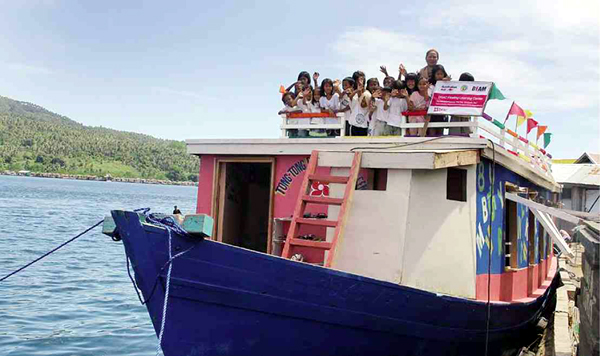
CHILDREN of Laminusa Island in Siasi, Sulu province, hold classes on a floating school ARMM BUREAU OF PUBLIC INFORMATION
DAVAO CITY–When classes opened early this month, there was no first-day high or school supply-buying frenzy for 7-year-old Liza Jabara, a child in the coastal village of Tampakan on the island of Laminusa in Siasi, Sulu province.
Instead, like many Badjao children, Jabara was riding on her father’s outrigger.
Jabara’s family lives in a village of small huts on stilts. Most of their needs they get from the resources offered by the waters surrounding the island.
But the government and community leaders are optimistic that the lives of the people on the island, most especially the children, will soon change.
The Autonomous Region in Muslim Mindanao (ARMM), the Department of Education and Bangladesh Rural Advancement Committee (BRAC) Philippines recently delivered a floating school in the hope that this would help address the gap in education.
BRAC Philippines is implementing the Alternative Delivery Model project component of the Australian government-funded Basic Education Assistance for Muslim Mindanao.
On June 16, Jabara and 29 other children in her village attended their first class on one of the floating schools moored in their community.
“Before, our lives mainly revolved around our home, play and helping our parents fish,” Jabara said.
Seven floating schools were brought to seven different villages in the provinces of Basilan, Sulu and Tawi-Tawi to cater to the needs of at least 200 Badjao and Sama children this school year.
The BRAC Philippines country representative, M Nazrul Islam, explained that the floating school model was adopted from the “boat school” project implemented by their organization’s head office in Bangladesh.
Islam added that they believed the model was more suited to the culture of the Badjao and Sama people who were “mostly reluctant to mingle with people belonging to other, more dominant Moro tribes.”
BRAC’s main thrust in the region is to implement innovative and community-driven learning methods that address the needs of marginalized communities.
The organization operates a total of 1,220 learning centers, including the floating schools, in the region. It also serves about 40,000 children in remote and troubled areas.
Danny Jardan, a Badjao teacher, appealed to the students to never take their education for granted.
“Don’t be lazy to attend school every day. It’s the only chance for you to help get your family out of poverty,” Jardan said.
To further address the problem in the education sector, the ARMM recently hired more than 1,000 teachers to become part of the workforce that will help provide education in the region.
And as classes start, the parents were as excited as their children.
“We are very thankful to you—to BRAC, to the ARMM government—for this school. Otherwise, my children won’t be able to get an education,” said Rosemaria Saibung, whose two children have been enrolled in the school.
As what the Badjao and Sama people usually say, big waves start from small ones.